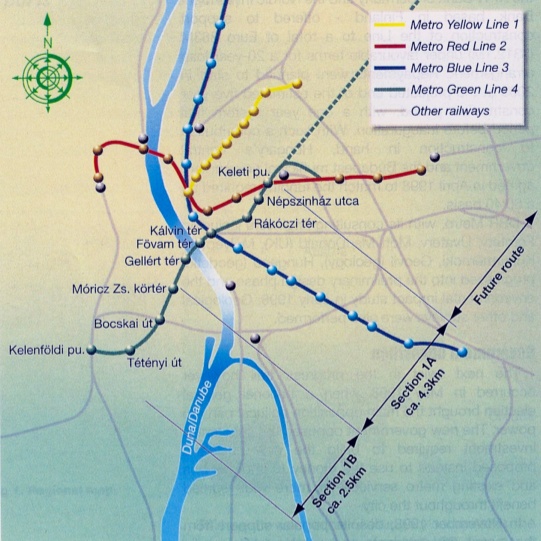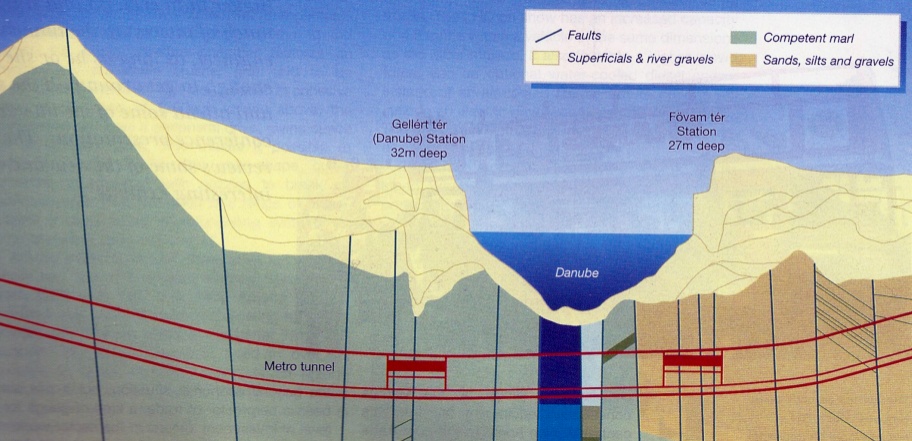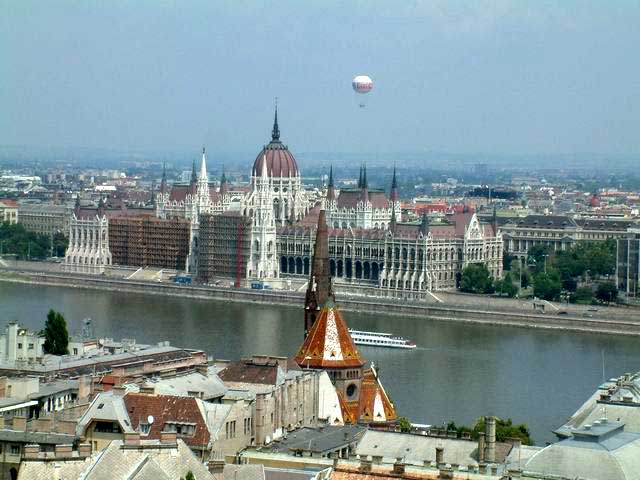Budapest Metro waiting for a green light
June 2001
Shani Wallis, TunnelTalk
-
Political wrangling in the late 1990s/early 2000s stalled construction of the Budapest Metro Line 4. Shani Wallis travelled to Hungary in 2001 to investigate why progress was problematic.
- Running diagonally across the city from north-east to south-west, Line 4 of the Budapest Metro is the next obvious extension of the city’s underground mass transit system. Building on an existing metro network of some 34.6km, which started operation more than 100 years ago, a new 7.5km Green Line 4 with 10 new underground stations would connect with the Red and Blue Lines on the Pest side of the city and passing under the River Danube into the 11th District on the Buda side (Fig 1).
-

Fig 1. Alignment of Line 4 under the Danube
- This south-west zone of Hungary's capital is the largest and the fastest growing of its 22 districts with a quarter of Budapest's 2 million residents living there creating 360,000 commuter trips daily. Traffic corridors into the area are the busiest, and bus Route 7, to and from the city centre, has head ways of less than one minute to cater for the heaviest ridership of all city bus routes.
- Metro Line 4 would reduce bus ridership by a mighty 85%. It would not only provide a faster and more convenient method of transportation for the passengers, but would also reduce traffic congestion significantly and take a major step towards addressing the city's air pollution, which is a chronic health hazard in the summer months. Reducing heavy traffic would also contribute significantly to protecting and preserving the ancient spas, baths and monuments in the famous Gellert area, which is a listed UNESCO World Heritage site.
- Budapest's underground metro system is the oldest in mainland Europe. The first line, the 4.3km Yellow Line, with 11 underground stations, was built in 16 months by cut-and-cover and opened in 1896 for the Budapest World Expo. Ideas for the Green Line 4 date back to the 1930s when the first rapid transit masterplan was being considered. The Red and Blue Lines however took priority as the city developed. The 10.6km Red Line, with 9km and nine deep stations of up to 38m underground, was completed between the 1960s and 1970s. The Blue Line, the longest, at 23km and mostly underground, was started in 1972 with the last four of its 20 stations opened in 1990.
- A large portion of the underground network is shallow cut-and-cover construction and there are also long compressed-air shield-driven tunnels on the Red and Blue lines.
- Construction of the Green Line 4 requires state-of- the-art tunnelling with a combination of open cut and mined station excavations. Construction impact along the route, through the busiest parts of the city, must be minimised and traffic on the Danube cannot be interrupted. Pressure for the added public transport capacity requires that construction of the line is completed in the shortest time possible.
-

Fig 2. Simplified geological section of the new route under the River
- EPB or slurry tunnelling technology is required through the silty sands and gravels of the Pest side of the city and through the geological faults and zones that define the course of the Danube, while open face shields would handle the relatively hard marl of the escarpment on the Buda side (Fig 2). Where possible, the stations are large slurry diaphragm wall supported open boxes. Where surface space is limited, for example either side of the Danube, diaphragm wall access shafts will lead to mined station platform caverns. The necessary tunnelling technology is now widely available and with traffic management demands and environmental protection concerns adding to the economic and logistical urgency of Metro Line 4, the only stumbling block is politics.
Political maze
In 1990 Hungary, along with most of its fellow satellite nations within the East European bloc, regained democratic independence and the metro, previously State funded, became the responsibility of the newly inaugurated national and city metropolitan governments. All went well initially. In 1992, the central and city governments approved construction of Line 4, agreeing to share the cost 50/50, and released an invitation to tender.- The return of tenders sounded the first warning signals. All three were 30-40% higher than the construction estimates. As a result, in Autumn 1994, progress on Line 4 was stopped, the 1992 tender initiative was cancelled, and the city's municipal government approached the European Investment Bank (EIB) for funding assistance. For the EIB to consider the request, a European-standard feasibility study with international competitive tender price estimates was required.
- This feasibility study was funded by a €800,000 (US$690,000) grant from PHARE, the European Union agency established to assist development in former communist central and east European countries. Prepared by a consortium of Systra -Sofretu-Sofrerail (France), Symonds Travers Morgan (UK), and nine Hungarian consultancy companies, the study was concluded in November 1996 and submitted to PHARE for review. In its findings the study confirmed the underground alignment of the original 1970s project as the best solution for the new 7.3km long line with its 10 underground stations, and put forward an estimated construction cost of €514 million, (US$441.9 million). This included the cost of fully automated rolling stock and a train depot at the south-west end of the line. The study also suggested a significant change, recommending that, instead of going underneath, the new line should go over the top of the existing Red and Blue Line interconnecting stations. This would keep the line as shallow as possible to maximise the space of the cut-and-cover stations, facilitate passenger movement through the stations, and minimise the cost and installation of escalators and lifts.
- To meet the needs of this more complex procurement process, the DBR (Del-Buda- Rakospalota) Metro organisation was established in early 1997 to manage the development and implementation of the Line and negotiate with international funding agencies.
- At the end of 1997 and on the strength of the feasibility study, three international banks - the EIB, the KFW Bank of Germany and the Nordic Investment Bank based in Finland - offered to support construction of the Line to a total of €363 million (US$312 million) and under favourable terms for a 20-year loan arrangement. Repayments were planned to start in 2003 at the projected end of the estimated five-year construction period, with a one year system trial period before inauguration. With such a financial contribution for construction in hand, Hungary's central government and the Budapest municipal government agreed in April 1998 to match the funding required on a 60:40 basis.
- DBR Metro, with its consulting engineers including Fomterv, Uvaterv, Mott MacDonald (UK), Melyepterv Kulturmernoki, Geovil (geology), Hungeod (geodetic) progressed into the preliminary design phase and the environmental impact study period in early 1998. Geological and other surveys were also performed.
-
Government opposition
The next twist in the progress trail however occurred in May 1998 when a national general election brought the main opposition political party to power. The new government opposed the substantial investment required to build the new line and proposed instead to use the money to improve bus and existing metro services for more wide spread benefit throughout the city. - In November 1998, despite popular support from the mayor and residents and a high profile media campaign, the central government withdrew financial support for Metro Line 4 and refused to provide further state guarantees to underwrite loans, and in fact, breached a formal agreement for €50 million (US$43 million) with EIB. Six months later in June 1999, the city successfully sued the central government claiming that it had acted against the law in rescinding its initial project approval.
-

New line passes under the Danube and the historic heart of the city
- A second court case, started in September 1999, is now seeking to force central government to reinstate support for the project and restore the commitment to cover 60% of the cost. "We are now awaiting a ruling," explained Laszlo Gulyas, Project Director for DBR Metro in an interview in May 2001. "Meanwhile, valuable time is being lost. Line 4 has been needed for more than a decade. Economists and city planners agree that the city will suffer significantly if the Line fails to be service within five years. "
- According to Gulyas, there have been international offers to design, build, and operate the line on a franchise basis, but the municipality cannot enter such agreements without the approval of central government. Nor can city government meet the full funding shortfall from current budget revenues.
- In efforts to mitigate the impact of further delay, DBR Metro, with the city government, is to press ahead with surface preparatory works without waiting for a decision from the second court hearing. "Meanwhile the next general election is scheduled for May 2002 and all may change again as a result."
- Under the early works programme, the diaphragm walls and the upper deck of the 10 underground stations will be installed leaving excavation for a later phase. "These are the most important and essential elements of the stations," explained Gulyas, "and we have already started the procurement process. We have invited tenders for the design work and will release documents for open international tenders for at least two diaphragm-wall contracts. This construction work is not complicated but it is significant in percentage of the overall station construction costs. Documents for prequalification of interest from contractors for the main station construction cannot go ahead until the funding arrangements are secured and a start date for construction set. Design documents for the preparatory works contracts are ready for release in June 2001 and we would hope to have construction of the station walls in progress by 2002. All invitations to tender for Metro station structures contracts will be published for all interested firms.”
- Other early works include start of geodetic and geological surveys, preliminary design, and the start of an EU-standard environmental impact assessment, required by law in Hungary since 1995. In addition, all buildings along the underground route are being surveyed and will be fitted with electrolevels and other instrumentation to monitor surface settlement and ground movement during metro construction. More than 10,000 units are in use along the alignment on offices, apartments and industrial facilities. There are several important historical monuments and buildings on the line as well as the embankment walls of the Danube. All these early works contracts are directly with, and are being funded by, the city municipality government.
- In advance of these developments, a preliminary structures and systems design was completed during 1998 by a consortium of Fomterv/Uvaterv of Hungary and Mott MacDonald of the UK to procure the permits for railway authorisation design. Also in August 1998, a €14.3 million (US$17.2 million) contract for project management services was let to Eurometro, a Hungarian led consortium of Eurout, MAV and OTP Ingatlan of Hungary with Louis Berger of France, the Paris-based office of the US consulting firm headquartered in Washington DC. Under these studies, local plans for the station sites were approved by December 2000 and surface arrangements for station entrances and intermediate ventilation shafts are also confirmed.
-
Estimates
In budgeting for the early construction contracts, Gulyas said that the estimates from the 1996 feasibility study are being used. "There is now a plan to assess new estimates," said Gulyas. "The next indication of total cost will be the market prices returned with contract tenders." - Estimating the cost of the Line, as the first major construction project open to international construction market forces in Hungary since the change of political status, has been a challenge. "We have studied the design of recent metro line projects in other European cities together with the relationship between design and total construction cost," said Gulyas. "Only the recent Madrid Metro construction projects are cheaper than our estimates. All others - the Jubilee Line in London and new lines in Berlin, Lisbon, Paris and Copenhagen and others - carry higher overall construction costs."
- Economics have also dominated design de cisions. Cut-and-cover stations between twin tube running tunnels about 14m deep and passing over the top of the two existing Red and Blue line underground stations, have substantially reduced estimated costs. The deepest part of the Line will be the crossing of the Danube where the stations either side are 32m and 28m deep. These two stations together with the Kelenfoldi pu station will be the most expensive station contracts. From the limited surface sites, the diaphragm wall shafts will provide access for proposed NATM excavation of mined station-platform caverns.
- Fully automated trains will be 80m long, and comprise four 20m long cars carrying up to 670 passengers each. These long trains require station platforms of 120m long. The technology selected for the new line is envisaged to be the prototype for possible rehabilitation of the existing Red Line.
- "We are also looking at different types of contracts to make up for the time we have lost since the 1998 election," said Gulyas. "These include partial turnkey and partial design-build contracts. The system wide operating services and supply of the selected rolling stock will be procured on a design and construct basis. Meanwhile, geological investigation and design of the whole line will continue through the early works stages.”
- If construction can start in 2002, in combination with the early works programme, the new line can be expected to open in 2006-7. Meanwhile, unless the situation is resolved soon, Metro Line 4 is sure to become a political football in the run up to the country's next general election in May 2002.
|
|
|
|
|
Add your comment
- Thank you for taking the time to share your thoughts and comments. You share in the wider tunnelling community, so please keep your comments smart and civil. Don't attack other readers personally, and keep your language professional.
